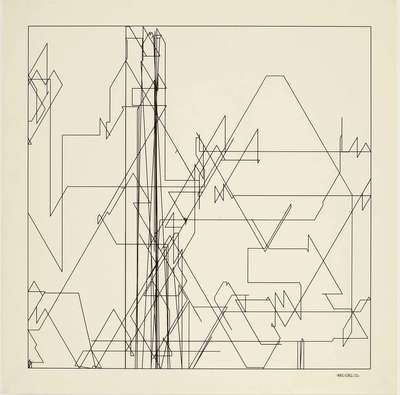The algorithm “Random Polygon” (which is part of the package compArt ER56) is used in an unusual way here. The drawing consists of one polygonal line only, which fact may not appear obvious at first sight. – A polygon is a sequence of vertices connected by straight line segments (“edges”). At each vertex along the polygon, the direction and length of the next edge are chosen randomly. The random choice of the direction follows a discrete probability distribution. The set of permitted directions is responsible for the particular visual appearance. The usual kind of random choice by the time (1965) was (and still often is) a uniform probability distribution over all directions. In this experiment, however, the choice of next direction is restricted. Only the horizontal, two oblique directions, and slight deviations from the vertical were permitted. This restriction creates the peculiar visual effect of the drawing. The restrictions clearly result in a more consciously composed structure. – The drawings of this experiment demonstrate the strong influence an advanced selection of probability distributions for random number generators may have on the aesthetics of even a simple constructive schema as the random polygon.
»13/9/65 Nr. 3 "Zufälliger Polygonzug"«
by Frieder Nake
| i |

| creators: | Frieder Nake |
| title: | 13/9/65 Nr. 3 "Zufälliger Polygonzug" |
| also known as: | Random Polygon |
| year: | 1965 |
| material: |
drawing, b/w, computer-generated Pen-and-ink drawing on paper Size: 43 × 43.1 cm Marks on the drawing: „sign.u.bez.u.r.inderZeichnung: NAKE/ER56/Z64; |
| algorithm: | Random Polygon in program package compArt ER56 |
| artwork type: | drawing |
Description
Artists
Illustrations
Comments
enter new comment

